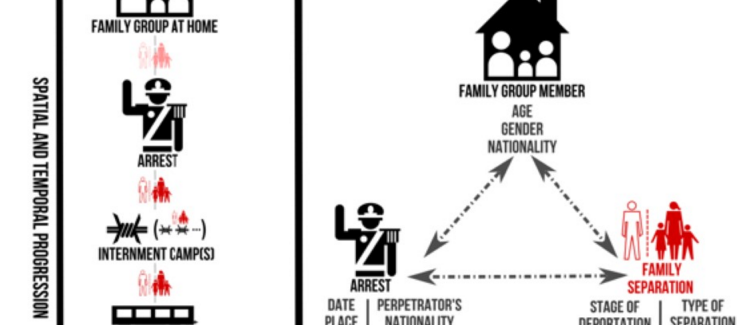Holocaust researchers have given relatively little attention to how victimization of individuals might differ from that of families. This thesis contributes to the literature by examining Jewish families’ victimization during the Holocaust in Italy from a Geographic Information Science (GIS) and historical geographical perspective. It is guided by the following questions: What were the spatio-temporal patterns of Jewish family arrests and deportations in Italy between September 1943 and February 1945? Are those patterns different from the spatio-temporal patterns of arrest at the individual scale identified in the literature? How often, and under what conditions, were family units maintained, separated, and/or reunited?
In order to answer these questions, this thesis employs a novel approach relying on digital technology to refine the data and conduct the analyses. Two python scripts were designed to identify family groups from a list of 6,116 individual victims of the Holocaust in Italy and to determine if and when families were separated. Then individuals’ and families’ experiences were compared using statistical and GIS analyses focusing on (1) spatio-temporal patterns of family arrests and separations, (2) the frequency and type of family separations, and (3) the effect of explanatory variables, such as Italians or foreign born families, nationality of perpetrators, gender, and age, on the degree and frequency of family separation and on overall vulnerability.
Results revealed that more than half of the Jewish victims of the Holocaust in Italy were arrested with members of their family, and that families were often separated, either by arrest or during deportation. Moreover, families were found to be particularly vulnerable to large-scale round ups, such as the one that occurred in Rome in October 1943. Among the families that were not arrested in such round-ups, many families were arrested at the border between Italy and Switzerland, probably while trying to escape arrests and persecutions. The majority of those Italian families trying to escape were not complete nuclear families, which illustrates the fact that some victims of the Holocaust made the choice to flee even if that meant leaving part of their family behind. To the contrary, data suggests that Jews trying to escape from the Vichy regime in France arrived, and were arrested, in Italy with their entire nuclear family. Those two findings raise questions about agency and survival strategies taken by Jewish families during the Holocaust which could be explored in future studies based on a more qualitative approach.
Regarding family separations, this study showed that Italian Jews as well as victims arrested in 1944 or 1945 were more likely to be separated, either during arrest or during deportation, than non-Italian Jews or victims arrested in 1943. Similarly, children were more likely to be separated from family members than adults during deportation, while gender did not seem to have a particular effect on separation likelihood. This analysis also established that victims arrested by Italians, alone or with Germans, were more likely to be separated from family members, both during deportation and in some cases during arrest, than victims arrested by Germans alone. Although this piece of information cannot be interpreted as a deliberate attempt of Italians to separate families, it nevertheless questions once again the already challenged “italiani brava gente” myth. Additionally, this study suggests that family separation tended to be more likely in locations where a moderate or a small number of victims were handled by the perpetrators, in opposition to large detention centers and large-scale round ups where the likelihood of being separated from family members was lower.
Overall, this study demonstrates that it is possible, and valuable, to study the Holocaust at the scale of the family. This scale of analysis not only permitted to research family separation, a previously unexplored phenomenon, but it also provided results and insights that were sometimes different from those obtained from studies performed at the individual scale. Such methods using family as a unit could be reproduced in different contexts, particularly in genocide and forced migration studies. Finally, this research shows the value of geography, and in particular GIS, for Holocaust and genocide studies. Indeed, GIS and spatio-temporal analysis were fundamental in uncovering family vulnerability patterns.
This post presents my thesis titled “Family arrest and separation during the Holocaust in Italy” completed in May 2016 as part of my Masters of Science in Geography at Texas State University.
